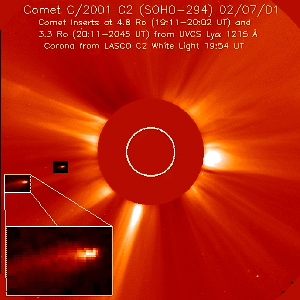Yet Another Comet Captured
Click on the image for a larger version. |
 |
|
Also available: 1024x1024 JPEG,
2100x2100 TIFF LASCO C3 movie: South-East quadrant: 256x256, 512x512, full field 512x512. |
Caption: Comet C/2001 C2 (originally designated SOHO-294) was discovered in LASCO C3 images on February 6th 2001, and has been confirmed as a member of the Kreutz family of Sun-grazing comets. These comets are believed to be fragments of a parent body which was torn apart some time in the distant past. The image above is a composite of LASCO C2 data, the white light corona at 19:54 UT, and two UVCS observations of the comet itself. The UVCS images represent observations taken at 4.82 and 3.32 Solar Radii (Ro) over a time span of 19:11-20:02 UT and 20:11-20:45 UT respectively. Each UVCS image is a time sequence of several 200 second exposures as the comet passed across the entrance aperture. The UVCS comet images have been approximately positioned and scaled to the LASCO corona image. A wide, well-defined tail can be seen in the magnified version of the 4.82 Ro observation.
Solar radiation heats the comet which in turn causes the outgassing of the water molecules and dust. The dust scatters sunlight at visible wavelengths, making the comet bright in LASCO images. The water molecules break down into oxygen and hydrogen atoms, and the hydrogen atoms interact with the coronal plasma. The hydrogen atoms scatter Lyman Alpha (1215 Angstroms) radiation from the Sun. The UVCS images represent the brightness at this wavelength.
Several properties of the comet and the encountered coronal environment can be determined from this observation. The outgassing rate of water molecules was calculated at ~100 kg/s and the size of the cometary nucleus was on the order of 10 meters during the UVCS observations. The comet also acted as a probe for the determination of coronal conditions. Densities of about 10,000 particles per cubic centimeter at 4.82 Ro and 86,000 particles per cc at 3.32 Ro were found. This sharp increase suggests that the comet passed from a fast solar wind region to a denser slow solar wind area. All of the results presented here are preliminary estimates.
Related Links:
Credits: Thanks to Doug Biesecker (LASCO) for his early reporting and position estimates, Brian Marsden for the orbit prediction, and the UVCS ops and science teams (Michael Uzzo, Kuen Ko, Rai Wu, John Raymond) for making this observation possible.
Instrument/observatories: UltraViolet Coronagraph Spectrometer (UVCS);
Large Angle and Spectrometric Coronagraph (LASCO);
Taken: Between 08:42 UT on 6 February 2001 and 20:45 UT on 7 February 2001.
Picture credit: SOHO/UVCS and SOHO/LASCO (ESA & NASA)


